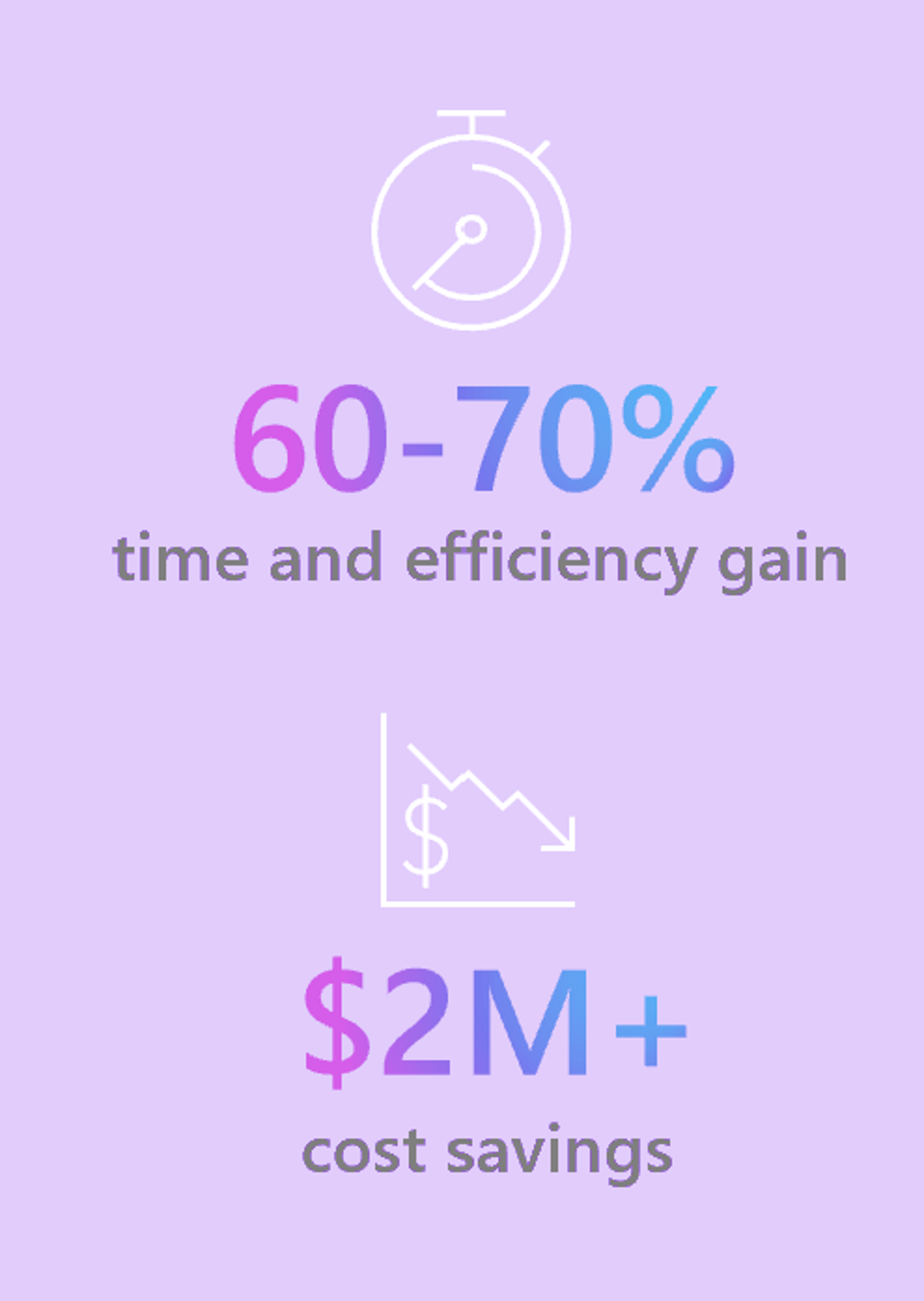
Partner Audience: #AllPartners #ISV
Relevant to: #SuccessStory #GoToMarket #Azure
87% of customers believe that AI will give them a competitive advantage,1 but not every customer knows how to get started. Providing viable use cases, sharing best practices, and setting clear desired outcomes help organizations undergo successful AI implementations.
Azure OpenAI Service is a powerful offering that integrates OpenAI’s advanced language models and services into the Microsoft Azure platform. With Azure OpenAI, customers get the security capabilities of Azure while running the same models as OpenAI.
Let’s explore how the testing of various Azure OpenAI use cases led one innovative company to realize increased productivity and cost-savings across the business.
A culture of innovation drives AI initiatives
North Atlantic Industries (NAI) supplies rugged embedded computing solutions and power supplies for the world’s largest and most demanding defense, commercial aerospace, and industrial applications. With over 65 years of experience and a focus on delivering rapid, reliable solutions that meet mission-critical needs, NAI defines every action and investment based on the ability to help its customers “accelerate their time-to-mission.”
A small company of 250 employees, NAI fosters a culture of innovation and exploration of new technologies to help improve processes and drive initiatives around reducing technical debt and maximizing efficiency. This culture sets the stage for employees to test various AI use cases and take a company-wide, iterative approach to AI adoption, resulting in numerous successful implementations that enable intelligent automation of routine tasks to deliver significant time, cost, and efficiency gains.
I am extremely supportive of our teams leveraging emerging technologies to solve previously unsolvable problems. Azure OpenAI is a force multiplier that is accelerating our productivity and letting us compete on a higher playing field.”
– William Forman, President and CEO, NAI
Leading the charge and realizing impact with AI
Staying true to its innovation-driven culture, NAI’s software engineers began looking for ways to incorporate AI to drive efficiency in their daily tasks and, ultimately, for the business. The first use case that became apparent was during a modernization effort to add comments to and clean up a code base of over 100K lines of code, all written in C#. Making the updates manually proved to be an enormous effort, which inspired the idea to implement an AI-driven solution to help automate and accelerate the process. “We wrote a program with Azure OpenAI that takes the source code and writes a comment for every function automatically, and everyone is excited about that because it ensures consistency and helps save programmers a lot of time,” says Lacey Stein, Software Engineer at NAI. “It really got everyone interested in wanting to explore AI more.”
When it came to selecting an AI solution, Tim Campbell, Director of Workplace Technology at NAI, notes several reasons that made Azure OpenAI the obvious choice. “From a cost perspective, the context window and rate limit Microsoft is giving us is beating anything else on the market,” shares Campbell. “We were also already familiar with OpenAI, so realizing the partnership with Microsoft led us right to Azure OpenAI services, which is our bread and butter right now.”
Taking Azure OpenAI company-wide
Following the success that the engineering team was finding with its initial Azure OpenAI use case, interest and involvement in AI initiatives grew across the company. They established a regular “best practice” session with other business groups to share how AI initiatives are performing and discuss ideas for additional use cases that could bring improvements to other departments. “It’s not just IT or engineering who participate in these discussions, we bring everyone together across sales, purchasing, program management, and manufacturing to talk about this AI and how we can use it to our advantage,” says Campbell. “Every corner of the company knows about it.”
These company-wide sessions have led to a growing number of AI use cases that have driven productivity and efficiency gains across the business.
Engineering
To meet customer assurance requirements for embedded software, NAI must perform software testing at many levels of the electronic system integration process. This effort includes writing and executing unit tests covering 500 different product functions on hundreds of hardware modules. Despite bringing in a third-party vendor to help aid in this extensive, manual task, progress was too slow to meet customer schedules. To accelerate the testing process, NAI brought testing back in-house, leveraging Azure OpenAI to detect missing unit test cases and significantly reduce the manual work and time necessary to complete each test. Ultimately, this strategy will save the company thousands of outsourcing hours and millions in costs. The team is seeing additional efficiency gains with Microsoft Copilot. “All of our engineers now have Copilot installed on their IDEs and love it. When AI can scaffold out a bunch of code that would take them a lot of time to do themselves, it is a huge time saver,” remarks Campbell.
Sales
When statements of work (SOWs) and client inquiries are received, program managers have traditionally needed to manually review and respond by locating and referencing past SOWs, which is time-consuming and inefficient. “Now, when we feed a statement of work into OpenAI it can refer to our prior proposal responses and assist our proposal writers. This improves the quality of SOW responses and gives our program managers a head start, saving them about 16 hours of manual work per proposal while improving accuracy and accelerating response times,” notes Campbell. NAI is also expecting to implement AI to streamline the request for proposal (RFP) process in a similar way.
Service
Currently in the proof-of-concept phase is a new AI-driven return merchandise authorization (RMA) system that improves the data infrastructure. With unstructured data, the current system requires service technicians to manually note problems and resolutions and then appropriately categorize the issues for future reference. The new system will leverage OpenAI to use the unstructured data and a set of standardized reason codes to automate RMA categorization and save technicians considerable time and manual effort.
In addition to the millions in cost savings achieved by eliminating outsourced code testing, NAI estimates that Azure OpenAI has delivered 60-70% time and efficiency gain by automating time-consuming, manual processes while dramatically increasing employee productivity.

Figure 1. Azure OpenAI delivers both cost savings and a gain in time and efficiency for customer NAI.
NAI has no plans to slow its exploration and expansion of AI use cases across the business and has several new implementations already in mind. One such initiative is creating an AI-driven Microsoft Teams site that has a complete knowledge base of the company’s products and manuals to answer queries on things like tolerances and tests right within the collaborative foundation of Teams.
The marketing team is similarly looking to incorporate a customer-facing AI bot for the company website that can leverage a deep knowledge base to help answer customer questions, as well as exploring AI-generated content to help the marketing team accelerate customer-facing content creation.
The engineering team is also working toward creating an AI program to automate hardware documentation. Currently, module manual writers must search and gather information across various sources, which is difficult and inefficient. Knowing how AI needs to ingest information has already inspired the team to start creating a central database of information in the hopes of eventually harnessing an AI-driven program to automate the documentation process. “Even if the program isn’t ready yet, just the thought of having AI has already been really helpful to our process,” says Stein.
Learn more about Azure OpenAI
What is Azure OpenAI Service? – Azure AI services | Microsoft Learn
Azure OpenAI Service | Microsoft Azure Blog | Microsoft Azure
Join the conversation
Want to explore this and other topics you care about with Microsoft and other US partners? Head over to the Microsoft Americas Partner Community on LinkedIn.
1 Expanding AI’s Impact with Organizational Learning, Findings from the 2020 Artificial Intelligence Global Executive Study and Research Project, MIT Sloan Management Review, October 2020.
